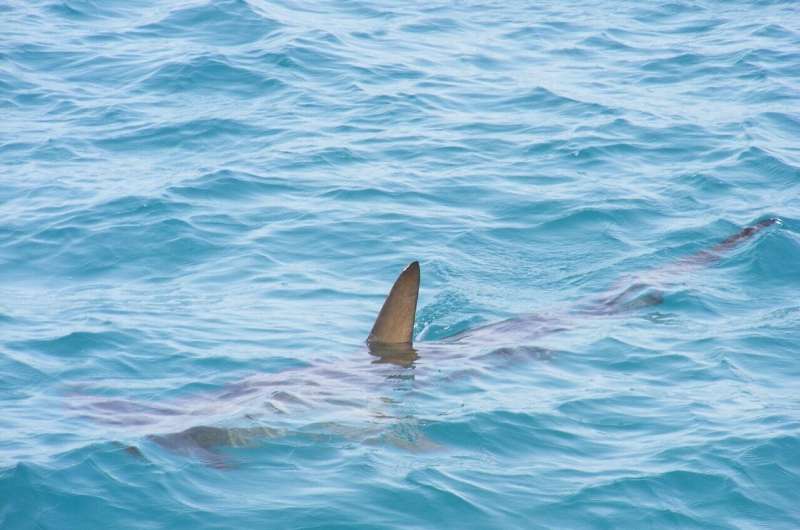This article has been reviewed according to Science X's editorial process and policies. Editors have highlighted the following attributes while ensuring the content's credibility:
fact-checked
reputable news agency
proofread
DNA tests confirm shark that bit California swimmer was juvenile white shark

A shark that bit a swimmer in Del Mar last month, leaving the man hospitalized with significant wounds, was a juvenile white shark, likely around 9 feet long and 6 to 8 years old.
That determination came from analyzing DNA left on a wetsuit worn by the swimmer on June 2, and bite marks on the fabric, said Chris Lowe, director of the Shark Lab at Cal State Long Beach.
It is unknown why the shark bit 46-year-old Caleb Adams as he was swimming with a group about 100 yards offshore near Del Mar's main lifeguard tower. Adams suffered wounds on his torso, left arm and hand during the Sunday morning swim on an overcast day when the water was murky.
Fellow swimmers heard Adams screaming and used a surfboard to help him onto the beach, where lifeguards and others provided first aid, applying a tourniquet to stanch his bleeding before loading him into an ambulance.
Adams told CBS 8 he was surprised how big the shark was and said he felt lucky to have survived. At one point, he punched the shark as it was biting him, causing injuries to his hand.
"I think my wounds reflect that it was only a portion of what the shark could have done, so I can consider myself really lucky," Adams told the station.
Adams has resumed swimming, but only in a swimming pool at this point, he told CBS 8.
Lowe said it could not be determined if the shark in the Del Mar incident was male or female. Fully grown white sharks can be up to 23 feet in length and live 45 to 70 years.
It is unclear why sharks sometimes bite swimmers. Lowe said they could be in feeding mode and mistake a human for food, or could bite as a defensive measure.
The water between Del Mar/Solana Beach and Torrey Pines is a known white shark nursery where many juveniles congregate. Researchers have tagged about 40 sharks in the area, where some stay for weeks or months at a time. Lowe said his group is trying to determine why sharks hang around certain beaches but said it could be that they like the water temperature, find plentiful stingrays and fish to eat, and can avoid predators by staying in shallow water.
Drone flights above such areas show sharks are often very close to swimmers, surfers and others in the water.
"Basically the advice is no different than the day after (June 2)," Lowe said. "People should be aware it is an aggregation site and there are sharks out there."
Water samples taken after the June 2 incident may eventually be analyzed for DNA to try to determine more about individual sharks in the area.
"We have to sequence all the DNA and then try to reassemble it to see if we can identify (the shark) as an individual," Lowe said. "It is a new technique, it has never been done before, and I don't have the money to do it. So I will try to find the money to do that part."
Researchers could use the DNA data to try to build shark family trees. "We can start to build these libraries and ask, who is related to who," he said. Such information could help scientists determine how many sharks are in the area and how they might be related.
Before that work can be done, however, Lowe said he needs funding to keep the California Shark Beach Safety program running.
State lawmakers allocated the program $3.75 million in 2018. It was supposed to last five years, but Lowe has stretched it to six. Even so, that money will run out Sept. 1, and no new state funds have been allocated.
The program covers 600 miles of coastline—from Morro Bay to San Diego—using tracking buoys, tagged sharks, drones and acoustic equipment to monitor shark movement and behavior. A team of 15 work on the project, including students.
The program was designed to improve the public's understanding of sharks and reduce safety risks. Part of the effort educates lifeguards about sharks and keeps them informed about shark activity at their beaches.
"The technology is expensive, but it gives us data you couldn't get any other way," said Lowe, who has taught marine biology at Cal State Long Beach for 25 years.
Lowe said he hopes to find private donors, or possibly city and county government funding, to keep the program afloat. "We're getting a little desperate," he said.
2024 The San Diego Union-Tribune. Distributed by Tribune Content Agency, LLC.




















